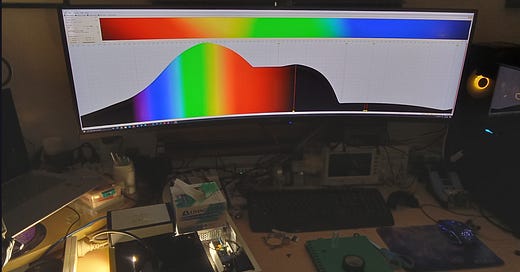I promised to share my attempt at a DIY spectrometer in the last post.
A fun project for others that may have some uses, but not likely for what I need. I need everyone's help buying an LCMS machine instead.
So the benefit of using a basic UV/VIS/NearIR spectrometer is that we may be able to compare products containing the same contaminants and see a similar representation of multiple wave peaks. If those peaks were all similar then we could say it is likely similar materials are in each swab we test, or as what is seen in vaccines. However, that is about the limits of it for testing complex matrices of material like things which self-assemble. What i need is going to cost more than the home made device has so far, and the reason for that is more advanced spectrometers using separation techniques that also use superior sensors can actually define individual materials in complex matrices. Simple spectrometers tend to need a singular or simpler sample to analyze. Testing something like bleach or water would be something that works well with simple devices. If there were contaminants they would show peaks, but in a complex sample you just could not be able to tell which material is what by any reliable or clear means
So here is the inside of my spectrometer. It has a 100W wide spectrum LED which reaches Near infra red and as low as 380nm, it has the power for low sensitivity waves to be picked up by the high-end imager on the other side of the cuvette (sample tube). Ultimately a narrower light source is best for lower nm resolution of sample imaging, according to calculations and with the slit sizes used i would of had pretty accurate readings still in the low nm range. The diffraction grating which splits the light from the sample into coloured beams is very high resolution offering 1800 lines over the usual 1000 lines of split found in the average several thousand dollar spectrometer. Results with an 1800 line grating and a high resolution imager of 4k would be higher than many spectrometers can achieve of this type. I was excited for this to be seen running. The camera had the IR filter glass removed to extend its range of sensitivity in the IR range.
Here was the general diagram i came up with for my design. Unfortunately i was missing something which we will see using two software’s for professional spectrometer devices
Above is our spectral graph reading live from the imager at low fps and high resolution. It samples the data and updates it every couple of seconds to the screen. Spectragryph software is extremely accurate software that works with some cameras (including modded webcams), high end large brand spectrometers, and Raman microscopes.
Explore the German designed software here:
https://www.effemm2.de/spectragryph/
you will find the Theremino software below at:
https://www.theremino.com/en/downloads/automation > scroll down half way to the spectrometer documentation and app download.
Theremino above is actually pretty impressive too. It can provide absorbance and reflectance information with reasonable accuracy, but Spectragryph wins hands down for a lab grade professional software with full features. Its not entirely free. It is free for personal use and some none commercial uses, but not commercial without license.
Anyway, so I test the spectrum of the light source LED itself which seemed vaguely correct in shape and range on both software. But when I tested water and lab samples of our vaccine and swab material it did not have defined waves of high resolution. after some heavy trouble shooting I realized that the LED spectrum was correct since it has little detail in its spectrum but the samples were not displaying on the imager preview as wide colour bands. The reason is that the imager needs to take the waves exiting the diffraction grating and have them focused perfectly at the imager. I calculated that it would almost not need the focal lens, but hey, it was going so well till that news breaker. I was considering this and nearly bought a focus lens for m42 mount cameras. A good optical focus lens that fits m42 industrial imagers with suitable optical glass is actually about $200-$400 and so I decided that since time is precious and my objective is to get answers as soon as possible. This spectrometer is useful, but will just be a distraction when I need to know accurate details about the material at hand. Time is running out, that i am 100% sure off.
Have a look into building webcam spectrometers if you are learning or think you might want to play with simple samples or compare complex samples. A cheap webcam of about 1080p and 30-60fps will actually work reasonably well with the glass removed and lens focus adjusted on in it. typically they can read from about 420nm to almost 1000nm.
learning resources:
We as the community investigating our demise, proving it, and finding solutions need a real piece of kit like an LCMS device and Raman microscopes or imager kits. Help us to do more by contributing to the LCMS of everyone’s dreams. Eradicate bio-warfare crimes forever. With everyone’s help it can be just around the corner. I have the time, determination, Qualified support and training, I just need a fully functioning LCMS to be able to bring truth to the table for all.
Thanks for reading and I wish all the best of health!









Being a car guy and enjoying the DIY aspect of all things mechanical I can appreciate your enthusiasm for building your machine.
Thanks for sharing your project and your results so far. Absolutely amazing !!!
Its not a Theremino-hat @https://substackcdn.com/image/fetch/f_auto,q_auto:good,fl_progressive:steep/https%3A%2F%2Fsubstack-post-media.s3.amazonaws.com%2Fpublic%2Fimages%2F936d15bd-e985-4334-a5f0-c1f68d3fe989_1203x366.png
It's a boa which has eaten an elephant.
The Little Prince said that (And also do i here, now, just for fun)
If we believe St Exupery.
Rhhha, Science is for the Astronome's planet....
Hahaha, and however, thanks for your job ! :-)